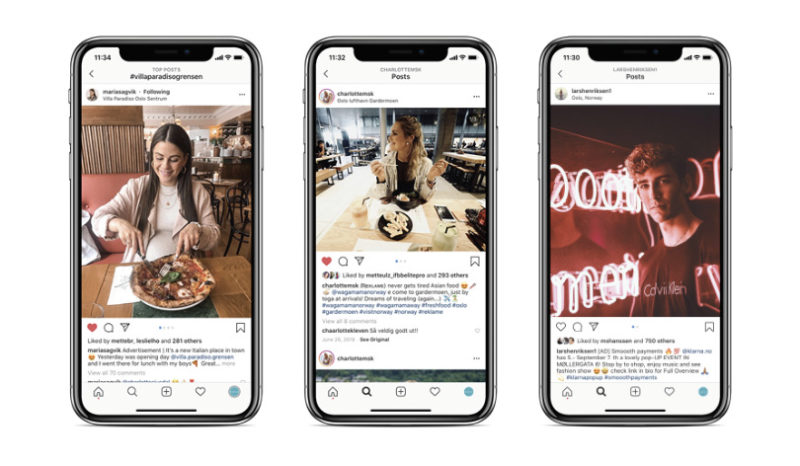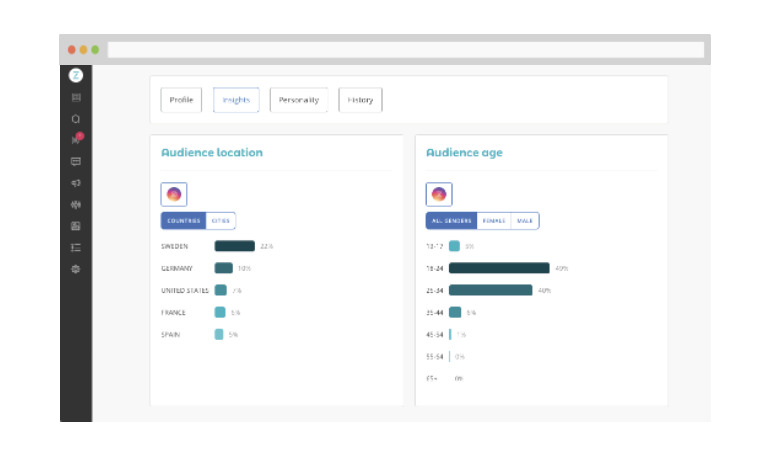Have you added influencer marketing into your digital marketing mix?
It’s a great way to build trust, generate high volumes of content, and break the noise! But to succeed with influencers, you first need to have a strong influencer marketing strategy in place.
This in-depth guide on how to build an effective strategy will give you the tools and insights you need to run effective campaigns in 2020!
Table of Contents
How to build a winning influencer marketing strategy
Step 1: Take an always-on approach
Many brands adopt a short-term, one-off campaign strategy. But to get ahead of your competition and truly reap the benefits of influencer marketing, you should consider shifting to a long-term approach.
With an always-on strategy, you’ll collaborate with social media influencers on an ongoing basis throughout the year. Here are 6 advantages this strategy will bring you:
- You’ll get a steady stream of content that you can reuse in ads and social media
- You’ll have a constant flow of activity and engagement created around your brand.
- You’ll develop strong relationships with social media influencers who are aligned with your brand. Well-matched influencers will deliver great results for your campaign.
- You’ll evolve and optimize your strategy as you review your collaborations.
- You’ll save time from explaining collaboration details and negotiating compensation, which you’ll need to do with every new influencer you onboard.
- You’ll keep your brand top-of-mind by frequently targeting the same audience with your branded message.
Step 2: Define your target market & target audience
Before identifying potential influencers or deciding on any goals for your influencer campaign, you need to define your target audience. By creating your ideal customer profile, it’ll be easier to understand who you should be working with and how they help you achieve your goals within your influencer marketing strategy.
To define your target audience, review your existing customers and ask yourself:
- What’s your ideal customer’s demographic? Review key data points such as age, gender, income, location, and more!
- What activities and interests do they have?
- What’s their life stage, or current stage in life? Are they retired? Expecting?
- What products do they buy?
- What problems are they trying to solve with your products?
Step 3: Outline your campaign goals & objectives
The key to any successful campaign is to have clear goals and objectives which align with your influencer marketing KPI’s. This will impact the metrics you track to measure whether your campaign was a success. 3 common goals and objectives include:
Step 4: Select your influencer marketing campaign type
There are a few types of influencer marketing campaigns you can launch. Each campaign type can contribute to your goals in various ways — you’ll need to evaluate the benefits of each in order to choose one that will contribute the most to your influencer marketing strategy.
Here are 5 common campaign types of influencer marketing campaign:
Sponsored content
Brands work with influencers to produce content that features their products or services on social media.
Great for: Boosting brand awareness and creating reusable content
Social media takeovers
Brands allow influencers to temporarily take over their social media channels.
Great for: Boosting brand awareness, generating engagement, and increasing traffic & followers
Events
Brands invite influencers to attend events for product launches, concerts, and fashion shows.
Great for: Generating engagement and boosting brand awareness
Competitions & giveaways
Brands give influencers a product or service that they can gift followers who win a competition or giveaway.
Great for: Boosting brand awareness and increasing traffic & followers
Discount codes & CPA deals
Influencers earn a profit for every sale they make, which are tracked with unique discount codes or links.
Great for: Increasing sales and converting leads
Step 5: Select your social media platform
Influencer campaigns can also occur on various social media channels. The channel, or channels, you choose to work on depends on the type of content you want to reach people with. Here are 3 of the most popular ones:
Instagram
This channel is the most popular for influencer marketing. Because Instagram posts don’t take too much time and resources to create, it typically requires a smaller budget than Youtube or Blogs
Instagram influencers will be able to create 3 types of posts: sponsored posts, stories, and IGTV videos. They can share personal stories in their captions, create a sequence of eye-catching content, share discount codes, capture authentic moments with stories, and create long-form videos.
Typical audience: Gen Z and Millenials, mainly 18- to 30-year olds
Youtube
Influencers on Youtube specialize in creating long-form videos. They can show how your product or service works, promote your brand in their vlogs, review your products, and feature your products in haul or unboxing videos.
Typical audience: A wide age range, with 81% of 15- to 25-year-olds and 71% of 26- to 45 year-olds using YouTube
Blogs
Influencers on Blogs are narrators, and they’re great at telling long, personal stories. In their blog posts, they can review your products or services, explain how your products work, create recipes or DIY projects with your products, and write about their experience with your brand.
Typical audience: 25- to 55-year-olds
Step 6: Research & identify relevant social media influencers
Once you’ve defined your audience and set your goals, you can start looking for influencers who will help you reach your ideal customers and fit your influencer strategy. You should first decide which types of influencers you want to work with, such as micro-influencers or macro- and celebrity influencers.
If you’re looking to generate a high level of engagement in your campaign, consider working with micro-influencers — influencers with less than 10,000 followers. Though they have a smaller following, their audience is incredibly engaged with the content they produce.
If you’re looking to generate reach then consider working with macro-influencers — influencers with more than 100,000 followers — and celebrity influencers.
But if you want to launch a campaign that generates high engagement rates and reaches a large audience, it’s best to work with a combination of micro-influencers and macro-influencers.
After you’ve decided on the size of influencers you want to work with, you should take time to research their social profiles and keep your eyes out for profiles that fulfill these 9 criteria. In brief, be sure to ask yourself:
- Does the influencers’ audience match your target audience?
- Are their profiles relevant for your products or services?
- Would their quality of content be a good representation of your brand?
- Does the influencers’ aesthetic align with your brand’s?
- Do they share genuine, personal stories with their followers?
- What values do the influencers have?
Remember, doing your research and building relationships with the right influencers will give a good impression of your brand. It’ll also create a smooth collaboration process and help you find influencers who could potentially become your brand ambassadors.
You can find both free and paid methods on how to find influencers in our detailed guide.
Step 7: Figure out influencer payments
To generate a great influencer marketing ROI, you need to figure out how much to pay influencers for collaborations. Currently, there’s no clear standard across the influencer marketing industry on how to do this. But we believe that the payments you offer should be fair and mutually beneficial — this will increase the chances of them accepting your collaboration request.
See our post on influencer marketing costs to learn more about the overall costs of setting up your strategy.
Depending on your influencer marketing strategy and the types of influencer campaigns you run, there are a few ways you can pay influencers:
Pay per post
We recommend using this payment type to maximize your ROI. With pay per post, influencers are paid flat fees for collaborations. The fees you pay influencers should be based on their performance in impressions and reach. They can then be adjusted according to how much they can help with your campaign goals.
To calculate performance-based fees, you can use free tools like our Instagram Pricing Calculator, which will offer you a range of fees. You can learn how to choose a higher or lower fee in our Instagram Pricing Guide.
Pay per click (PPC) or Pay per acquisitions (PPA)
Influencers are paid for each click, sign up, or sale they generate from their sponsored posts.
With these types of compensation methods, influencers often feel they aren’t being offered fair payments because their content is being undervalued. They may not earn enough to compensate for the effort they put into creating the sponsored content. That’s why many influencers tend to decline these types of offers.
Additionally, influencers may not be compensated for every sales in PPC and PPA deals. For instance, their followers may not click on the link the influencers share, but they may end up buying something from the brand anyway. In this scenario, they wouldn’t be compensated for the sale.
Pay by follower size
Influencers are paid based on the number of followers they have on social media channels. We don’t recommend this payment method because it won’t maximize your ROI.
As we’ve learned in our Instagram Benchmarks Report, influencers with large followings reach a smaller percentage of their followers. This means you’ll generate a lower ROI when you work with macro-influencers.
Products for post
Influencers are paid in products and services. As we’ve seen in collaborations, influencers have been less likely to accept this payment type. They want to be compensated for the time, effort, and resources they use to produce content.
They may work at a discount if they love the brand that reaches out or if their products and services are worth a considerable amount.
Acceptance rates can also vary depending on whether the influencer marketing industry has matured in the markets the influencers are located in. Influencers are less likely to accept products as compensation if the market has standardized.
Once you’ve decided how you’ll pay, you can include it in the influencer contract, or brief, you’ll send to influencers.
Step 8: Clearly communicate your expectations
When you contact influencers, you should send them a brief that clearly outlines your collaboration expectations and key performance indicators. This will help them understand what you’re trying to achieve and what’s expected of them. It’s also an opportunity for you to get them excited about your brand and convince them to work with you!
A great influencer marketing brief should include:
An introduction
In this section, give influencers an introduction of your brand and product. You should aim to explain:
- Who you are
- What you want the influencers to promote
- Why they should promote your products
This is the best place for you to sell yourself and get the influencers excited about the collaboration!
Compensation
You should specify what you’re paying or giving influencers for a collaboration. If you’re sending them any products or providing any services, be sure to include the value of the products or services.
Collaboration overview
In your overview, you should explain what you’ll require from the influencers. You should specify:
- Social media channels you want to collaborate on
- The number of posts you expect
- Branded hashtags or links you want the influencers to include. Note: If you’re planning to track conversions, this is where you should share any UTM links, unique discount codes, affiliate links, or custom landing pages with the influencers.
- Accounts you want them to tag
- Your campaign goals and key performance indicators
You should also let influencers know here that you will consider those who perform well as potential brand ambassadors for your brand in the future!
Collaboration guidelines
You can break down the collaborations in more detail. In this section, add any initial instructions for the influencers, such as providing a shipping address or ordering products.
You should also provide some guidelines for the content you want them to create. You can, for instance, explain how long Instagram stories should be or what you want them to reference in their captions.
We encourage brands to grant influencers creative freedom. One of the most important aspects of influencer marketing is the influencers’ authentic storytelling and content. But in order for collaborations to be genuine, you need to leave them room to create freely.
There’s a fine line between telling influencers what to post and working together to share inspiring stories. Strict limitations on content will make posts feel inauthentic, and they’ll look like ads — this will result in bad engagement. By granting influencers creative freedom, they’ll be able to use their creativity to create content about your brand and present it in a way their audience will enjoy.
You can also add a Do’s and Don’ts list to give influencers an idea of what you’re looking for.
Inspiration
To give influencers concrete ideas of the kind of content you’re looking for, you can also provide them with example posts you like or your brand’s mood board.
Deadlines
You should add dates you’d like the influencers to publish content on their social media channels by.
Content & results
To measure your campaign results and gather your content, leave instructions on how you want to receive them from the influencers.
Content usage rights
If you’re planning on reusing the content from your campaign in ads, websites, or social media, you should indicate that you’d like to have rights over the content that’s produced.
Disclosure guidelines
Many countries have disclosure guidelines in place that brands and influencers must follow when they share sponsored content. What’s expected of you can vary depending on the country you’re advertising in.
To ensure you’re meeting marketing regulations, you should provide clear instructions to the influencers on how they should disclose sponsored content. Read our guides for the disclosure regulations in the UK & US and the Nordics.
It’s important that you make your brief as easy to read as possible. You can do this by separating the content into sections, providing checklists, and keeping your sentences brief.
Step 9: Monitor your campaign
After determining influencer payments and creating the brief, you can launch your campaign. You’ll need to monitor influencer onboarding to ensure your campaign gets off to a smooth start!
Once you’ve sent collaboration requests to influencers, send them messages to welcome them and let them know they can ask you any questions. It’s important that you respond quickly, so they get a good experience with your brand and don’t lose interest in the collaboration.
As the influencers begin accepting your collaboration requests, be sure to follow the total cost of acceptances to check how close you are to hitting your campaign budget.
If you notice influencers aren’t accepting your collaboration request, you can: (1) add more influencers to your campaign, (2) edit your brief to make it more appealing, or (3) go over the reasons why influencers are declining to see what you can address to change their minds. Decline reasons may include low payments or tight deadlines.
Step 10: Measure your ROI
Once you’ve wrapped up your collaborations, you should measure the influencers’ results to determine whether your campaign was a success. How you measure your results can vary depending on your campaign goals.
How is influencer marketing ROI measured?
Brand awareness
You can measure the success of this goal by monitoring engagement (likes and comments), views, branded hashtags, mentions, and shares on the influencers’ sponsored posts. You can also check if your brand was mentioned or if your branded hashtags were used.
Compare the influencers’ engagement rates and reach to our Instagram benchmarks to understand how they performed.
Content creation
You can measure the success of this goal by counting the total amount of quality photos and videos that the influencers created in your campaign. You can also calculate how much each content cost you. You can then compare the cost against the fees you would pay a creative agency.
Conversions & sales
You can measure the success of this goal by adding up the amount of email signups, sales, app downloads, clicks, or followers the influencers generated in your campaign.
Step 11: Optimize future campaigns
Once you have an understanding of how your influencer marketing campaign performed, you’ll be able to identify which influencers worked well and which ones didn’t in your campaign. This knowledge will help you optimize and build better campaigns in the future.
As you measure your campaign results, be on the lookout for influencers who:
- Have engagement and reach on their sponsored posts that met or outperformed our benchmarks
- Have produced stunning, high-quality content
You should reach out to influencers who have performed exceptionally well to establish long-term partnerships with them. To replace those who didn’t, test a new group of influencers who have similar profiles to the influencers who performed well.
Step 12: Reuse influencer content
Lastly, don’t overlook the content from your campaign! Most brands struggle with producing enough content for their own social media posts and ads, but influencers can solve this problem.
Influencers include photographers and videographers, and they’re capable of creating stellar content. By integrating their content into your content strategy, it’ll help you with:
Credibility
Influencer content is high quality and in authentic environments, rather than professionally staged shoots.
Engagement
Consumers resonate and engage more with authentic content.
Cost
Getting content from influencers can be 10x cheaper than creative studios, and the quality can be of equal or better quality.
Content volume
Influencers can generate content on a massive scale, especially if you have long-term collaborations running.
You can reuse influencer content on your social media channels, paid ads, webpages, or email campaigns.
If you’d like help with implementing influencer marketing into your marketing efforts, check out our influencer marketing agency. We work with brands of all sizes to build awareness, drive consideration and increase purchases. Take a look at our influencer marketing case studies to see the results we get.
















